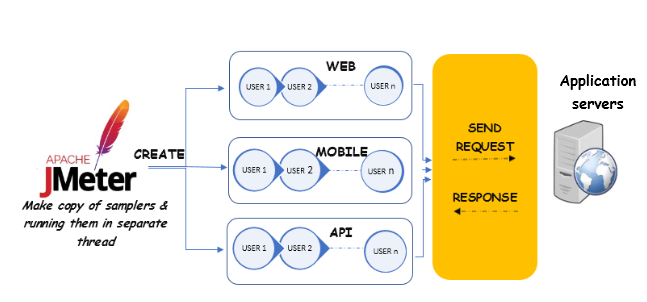Apache JMeter, along with it’s out of the box features is an open source Java based application software that can be used to perform load, stress, functional, performance and regression testing of websites, mobile applications, micro services and application architectures. This testing tool is used for analyzing and measuring the performance of a variety of services . Multiple users with concurrent threads can be simulated using JMeter, creating a heavy load against the application under test.
JMeter can be utilized to carry out all types of Performance Testing
- Load Test – To determine the transaction response times under desired load
- Endurance Test – Conduct the same load test for an extended period of time for determining sustainability
- Volume Test – To test the performance of the application at high volumes of data
- Stress Test – To determine the break point of the server
- Spike Test – To determine whether the application sustains sudden increase in load during abnormal conditions.

Salient Features of JMeter Testing tool:
- Performance of both static resource HTML, as well as dynamic resources, such as JSP, Servlets, can be tested.
- Determine maximum number of concurrent users that the website can handle.
- Provides variety of graphical representation of performance test reports which can be used for analysis.
- Since it is an open source application, it is totally free and allows architects to use the source code for the development and is also widely used tool in the market and has large online community support.
- Plugins can be added/removed as per requirements.
- Different servers and services like HTTP, HTTPS, FTP,Database, LDAP, SMTP, POP3, IMAP, TCP, SOAP, REST can be tested using JMeter.
- In addition to web applications, JMeter can be used to generate load for mobile Testing and API Testing.
Once the testing phase is over, it’s time to run the performance testing. And here the question arises. Paper or plastic? Not that question exactly, but close.
Your question is – Do I need to create my own testing lab, or do I opt for cloud-based services for running the performance test?
Why JMeter on Cloud for Performance Testing:
- Lowered capital and operational costs, and support for distributed development teams. Cost effectiveness depends on two factors; the number of activities and the infrastructure made available.
- No network latency related issues
- The maintenance of Cloud computing application is low, which further reduces the efforts.
- The Application performance is constantly monitored, and the web services are leveraged to develop loosely designed architectures.
- Cloud based testing helps to further enhance productivity enabling multiple users to work on the same database at a given point of time. This helps in saving time and deliver within the timeline demanded.
- Unlike non-cloud environment, Resources are made readily available in a Cloud set up. These resources are available on demand since they are external. This makes Cloud Computing highly reliable and efficient for enterprises who might need rapid availability of infrastructure for testing.
- No Geographical Barriers – Performance testing adepts can be hired from any country you want at varying rates, and there will be no problem in sharing the testing environment. All we need is a stable Internet connection.
- Multi location – The cloud gives the options to simulate the load from multiple location to mimic the Production usage. Say for example – Load can be generated from Tokyo, Singapore and Los Angeles concurrently.
- Testing at scale – Cloud-based testing providers offer a cost-effective means of testing applications at scale unlike lab environment that simulates a small subset of the production environment. Instead of testing an application against a portion of users, the application can be tested against the actual number of expected users when tested on cloud.
- Cloud testing services allow you to test your all-important applications under the real-life conditions. Cloud testing makes use of cloud-computing resources in order to simulate real users who come directly from the Internet.
- Testing globally – Cloud-based testing tools enable testing on a global scale, thereby reflecting the regions from which users are accessing the application. This is often done by partnering with other cloud providers, that allows customers to run load tests constituting millions of concurrent users coming from multiple continents.
As more IT organizations are becoming comfortable with the public cloud and leveraging it for critical applications, performance testing engineers must,
- Be prepared to test effectively in the public cloud environment.
- Understand the cloud infrastructure and the effects that infrastructure can have on performance testing results.
- Be aware of important infrastructure considerations that can significantly affect the load testing efforts while setting up the cloud-based load testing environment and interpreting the results of one’s efforts.
The more you know about cloud-based infrastructure environment variables, the more confident you will become with the performance metrics that your load testing tool produces.
Please reach for Performance Testing Practice at Novature Tech to create business driven solutions for your organization.
email : performancetesting@novaturetech.com
Contact – +91 7397666997
Author: Jaleel Mohammed | Posted On: 15th June 2018 | Category: Article






